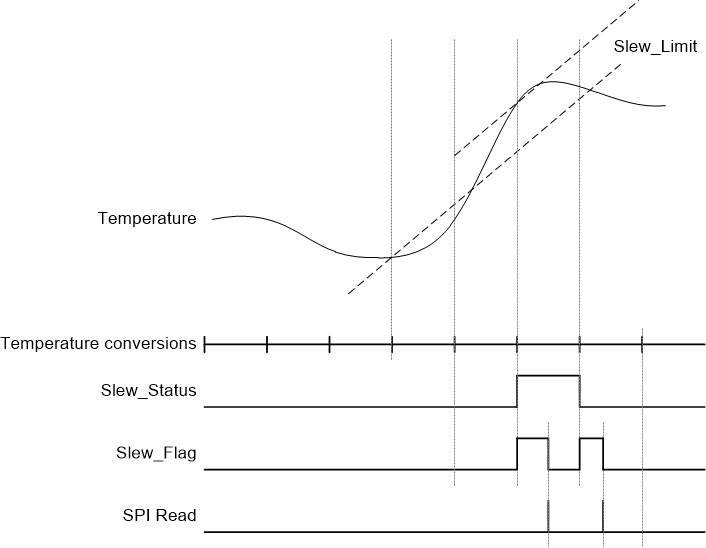SNIS227C May 2021 – June 2022 TMP126-Q1
PRODUCTION DATA
- 1 Features
- 2 Applications
- 3 Description
- 4 Revision History
- 5 Device Comparison
- 6 Pin Configuration and Functions
- 7 Specifications
-
8 Detailed Description
- 8.1 Overview
- 8.2 Functional Block Diagram
- 8.3 Feature Descriptions
- 8.4 Device Functional Modes
- 8.5 Programming
- 8.6 Register Map
- 9 Application and Implementation
- 10Power Supply Recommendations
- 11Layout
- 12Device and Documentation Support
- 13Mechanical, Packaging, and Orderable Information
Package Options
Mechanical Data (Package|Pins)
Thermal pad, mechanical data (Package|Pins)
Orderable Information
8.3.2 Slew Rate Warning
The slew rate warning is an adjustable alert option that can be adjusted with the Slew_Limit register.
The slew rate warning will notify the system of temperature spikes as they occur, allowing the system to react and correct for the increase in temperature before reaching thermal operating limits. Compared to throttling a system after crossing a thermal limit, the slew rate warning will allow a more safe system operation and greater reliability by not exceeding specified system operating conditions.
The Slew_Limit register is used to set the unsigned limit. The TMP126-Q1 will monitor the temperature slew rate and compare the positive change of temperature from the current conversion to the previous against the Slew_Limit. If the slew rate exceeds the Slew_Limit, the respective bits in the Alert_Status register will be set to indicate the warning. Figure 8-3 depicts the timing of the Slew Rate Warning relative to the temperature conversions. The slew rate check is always applied to the current temperature conversion and the previous temperature conversion.
Note the following considerations when using the Slew Rate Warning feature:
- Calculating the slew rate requires a fixed time period and is only available in continuous mode.
- Similar to other timing parameters of the device, consider that the slew rate calculation interval is impacted by the timing variation (tVAR) of the device.
- Slew rate calculation is supported for positive temperature changes (temperature increase) only.
- Take the sensor response time into account when using the Slew Rate Warning feature as the response time impacts how quickly the sensor responses to temperature changes.
 Figure 8-3 Slew Rate Warning Timing Diagram
Figure 8-3 Slew Rate Warning Timing Diagram